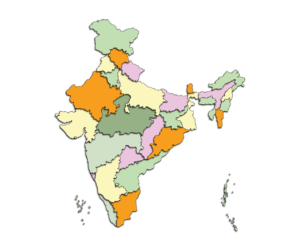Introduction
India is a diverse country with a wide range of agroecological zones, each characterized by unique combinations of climate, soil, and topographical features. These agroecological zones play a pivotal role in determining the types of crops that can be successfully cultivated in different regions. The selection of crops is a complex decision influenced by factors such as temperature, rainfall, soil fertility, and altitude. This article delves into the specifics of crop selection across various agroecological zones in Indian agriculture.
Tropical and Subtropical Zone
Crops:
The vast expanse of the Gangetic plains, coastal regions, and parts of the Deccan Plateau falls under the Tropical and Subtropical Zone. Here, the warm and humid climate fosters the growth of a diverse range of crops. Rice, sugarcane, cotton, jute, maize, groundnut, pulses, and tropical fruits are the cornerstone of agricultural activities in this zone.
Regions:
States such as West Bengal, Bihar, and Uttar Pradesh benefit from fertile alluvial soils and ample water resources, making them ideal for rice cultivation. The cultivation of sugarcane and cotton contributes significantly to the agrarian economy of these regions
Arid and Semi-Arid Zone
Crops:
Moving westward, we encounter the Arid and Semi-Arid Zone, spanning across Rajasthan, parts of Gujarat, Haryana, and certain areas of Karnataka and Andhra Pradesh. Characterized by water scarcity and high temperatures, farmers in this zone adopt crops with inherent drought resistance. Millets (pearl millet, sorghum), oilseeds (groundnut, mustard), and pulses (gram, lentils) take center stage in this arid landscape.
Regions:
In response to limited water resources, farmers often practice rainfed agriculture, relying on the monsoon for water supply. The cultivation of hardy crops ensures agricultural sustainability, and innovations such as drip irrigation are increasingly employed to maximize water efficiency.
Temperate Zone
Crops:
Venturing north, the Temperate Zone encompasses states like Jammu and Kashmir, Himachal Pradesh, and parts of Uttarakhand. With distinct seasons featuring cold winters and moderate summers, crops such as wheat, barley, temperate fruits (apples, cherries), and vegetables (potatoes, peas) thrive in this climate.
Regions:
Terrace farming is a common sight in the hilly terrains, allowing farmers to make the best use of available land. The cultivation of apples in regions like Himachal Pradesh contributes significantly to the country’s horticultural diversity.
Mountainous and Hilly Regions
Crops:
Mountainous and hilly regions present a unique set of challenges for agriculture. States like Himachal Pradesh, Uttarakhand, and parts of Jammu and Kashmir are characterized by steep slopes. Despite these challenges, crops such as apples, potatoes, temperate fruits, and specific varieties of pulses and vegetables find a niche in this region.
Regions:
Terracing is essential for effective cultivation, preventing soil erosion and ensuring sustainable agriculture. The cultivation of cash crops like apples serves as a vital source of income for farmers in these challenging terrains.
Coastal Zone
Crops:
The Coastal Zone, covering areas in Kerala, Karnataka, Maharashtra, Goa, Tamil Nadu, and Andhra Pradesh, experiences a warm and humid climate with proximity to water bodies. Rice, coconut, cashew, spices (pepper, cardamom), and various tropical fruits thrive in this coastal landscape.
Regions:
Coastal areas are susceptible to cyclones and saltwater intrusion, necessitating careful crop selection. Farmers adapt by choosing salt-tolerant crop varieties, and aquaculture becomes an integral part of the coastal economy.
Eastern Plateau and Hills Zone
Crops:
States like Chhattisgarh, Jharkhand, parts of Odisha, and West Bengal constitute the Eastern Plateau and Hills Zone. This region, characterized by undulating terrain and diverse soil types, supports the cultivation of rice, maize, millets, pulses, oilseeds, and various fruits.
Regions:
Advancements in agricultural practices, including the development of high-yielding crop varieties and improved irrigation infrastructure, have contributed to increased productivity in this region.
Western Plateau and Hills Zone
Crops:
Encompassing Maharashtra, parts of Gujarat, and Karnataka, the Western Plateau and Hills Zone exhibits varied agroclimatic conditions. Millets, oilseeds, pulses, and select horticultural crops are prevalent in this region.
Regions:
Sustainable farming practices, including watershed management and soil conservation, are imperative for maintaining soil fertility in the hilly areas. Diversification of crops helps mitigate risks associated with weather variability.
North-Eastern Hill Region
Crops:
The North-Eastern Hill Region, comprising Assam, Meghalaya, Mizoram, Nagaland, Arunachal Pradesh, and Tripura, boasts diverse agroecological conditions. Rice, maize, horticultural crops, and aromatic plants are cultivated in this region.
Regions:
Traditional farming practices coexist with modern agricultural techniques in this region. The cultivation of high-value crops, including tea and spices, significantly contributes to the economic landscape of the North-Eastern states.
Conclusion
In conclusion, the selection of crops in Indian agriculture is a nuanced process intricately woven into the fabric of agroecological diversity. Farmers navigate a complex landscape, adapting their practices to suit the specific conditions of each region. As climate change continues to impact agriculture, the need for adaptive strategies and resilient crop varieties becomes increasingly evident. Government support, technological innovations, and a holistic approach to sustainable farming practices are essential for ensuring food security and the economic prosperity of India’s diverse agricultural landscape. “Indian Crop Diversity” stands as a testament to the harmonious coexistence of agriculture and ecology, each playing a vital role in the nation’s growth and sustenance.


Good sir
EXCELLENT